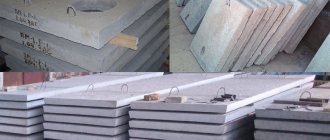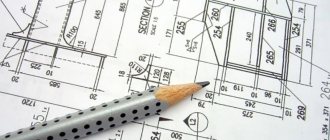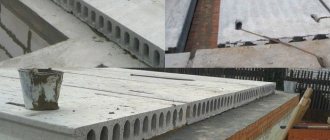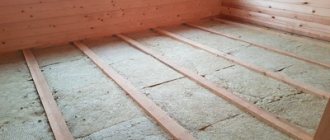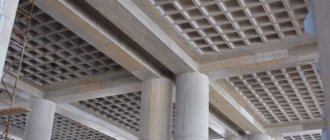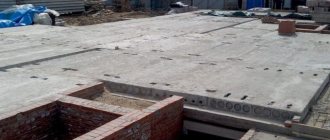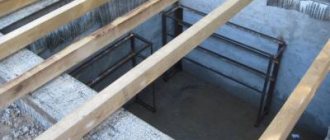Floor slab reinforcement: main advantages
Modern techniques, which open up new possibilities in construction, have important advantages.
- There is no need to search for heavy equipment, or rather cranes.
- There is an opportunity for the successful construction of a structure of any shape.
- The ceiling can please you with its high level of strength and resistance to any external factors.
- For a reinforced slab, additional structures, such as walls and columns, can be used as supports.
- It is possible to reinforce a monolithic slab for buildings where humidity reaches 60%. If there is a vapor barrier on the internal walls, the humidity in the room can be 75%.
- An optimal level of sound insulation is guaranteed.
What are the requirements?
PNO slabs have different sizes and characteristics. But all products must meet certain requirements, which will guarantee the quality and reliability of the future building.
Basic requirements for slabs:
- Exact compliance with all GOST standards
- Strict adherence to the dimensions and dimensions established in the documentation, absence of chips and visible damage
- Strength and fire resistance limit, optimal for a specific type of slab, corresponding to the calculations performed in the project
- Reinforcing the slab with reinforcement of the required class, in the volumes specified by GOST
- For ribbed slabs - the distance between adjacent ribs should be equal to 150 centimeters
- Optimal level of rigidity, resistance to various types of deformation
- Weight – affects ease of use and the total weight of the entire building
- Cost - must be justified and suitable for the developer
- Heat, sound, waterproofing - according to established standards
How to calculate the load correctly
The construction of any house cannot be done without correctly calculating the load that the floor slab can support. The rigidity of the entire building depends on it. Therefore, these calculations are the key to safe construction, this is a guarantee of the safety of people’s lives.
In each house, the floors have two structural parts:
- top;
- lower
The upper part transfers the load to the lower structure
Therefore, it is very important to accurately calculate the permissible value
Basically, the calculation of any building structure is simply necessary so that the building does not subsequently collapse. If the calculation is incorrect, the walls will begin to crack very quickly. The building will quickly collapse.
- dynamic;
- static.
Static calculation takes into account all objects that load the slab. All moving objects carry dynamic magnitude.
To perform the calculation, you must have:
- calculator;
- roulette;
- level.
The size of the slab determines its resistance to various loads.
To determine the load that the future floor slab can withstand, a detailed drawing is first made. The area of the house and everything that can create a load are taken into account. These elements include:
- partitions;
- insulation;
- cement screeds;
- flooring.
The main support system of the roof is located at the ends of the slab. When slabs are made, the reinforcement is positioned so that the maximum load falls on the ends.
Therefore, the middle of the structure will not hold up, even if it is reinforced with main walls.
To understand how the calculation is done, let’s take as an example a design like “PK-50-15-8”. According to GOST 9561-91, the mass of this system is 2850 kg.
- First, the area of the entire load-bearing surface is calculated: 5 m × 1.5 m = 7.5 sq.m.
- Then the weight that the stove can hold is calculated: 7.5 square meters. m × 800 kg/sq.cm = 6000 kg.
- After this, the mass is determined: 6000 kg – 2850 kg = 3150 kg.
At the last step, it is calculated how much of the load will remain after insulation, screed laying and floor covering. Professionals try to choose flooring so that it and the screed do not exceed 150 kg/sq.cm.
Then 7.5 sq. m is multiplied by the value of 150 kg/sq.cm, the result is 1125 kg. From the mass of the slab equal to 3150 kg, 1125 kg is subtracted, resulting in 3000 kg. Thus, 1 sq. m can withstand 300 kg/sq. cm.
Reinforcement: its necessity and types
A monolithic ceiling using a profiled sheet requires reinforcement. Concrete, by its structure, compresses well; reinforcement, on the contrary, stretches well. Combining these two qualities makes it possible to obtain a completely new and improved composite material that has very strong strength and durability values, capable of withstanding heavy loads and some deformations. Reinforcement is also used in concrete stairs.
Construction of a monolithic ceiling using a professional sheet
The reinforcement in the entire concrete structure occupies a certain place - in the zone of greatest tension, to help tightly compress the entire foundation. This reinforcement is called longitudinal. Another success factor is that the reinforcement must have good adhesion to the concrete, otherwise its function will not be performed as accurately as possible; for this purpose, special notches are applied along the entire rod of the reinforcement. Reinforcing bars are placed with a certain spacing for floors, equal to 15-20 cm. Depending on a number of factors, reinforcement can be installed in the lower or upper section of concrete. The greatest stress in the structure occurs in the lower part of the slab, at the top at the edges and in the center - these are the areas that are reinforced with reinforcement. The price of laying aerated concrete partitions is an order of magnitude lower, but is not always chosen due to the pressure and weight exerted on such floors, because aerated concrete is a fairly lightweight material. However, the loads still need to be calculated in advance.
The second type of reinforcement is transverse, it is located vertically. Thanks to it, reinforcement will be carried out as accurately and correctly as possible. Its appearance resembles supporting frames or bent parts. These elements are usually bent immediately on site from existing reinforcement; therefore, the reinforcement used for them must be taken into account when ordering the main reinforcement for a monolithic floor.
Reinforcement frame of a monolithic floor
If the slab is not heavily loaded, then transverse reinforcement plays an exclusively constructive role. If the loads on the slab are large, then this type of reinforcement will help protect the slab from destruction. Since in suburban construction there are practically no excessive loads on the slab, a constructive role is played - the concrete absorbs the supporting lateral force. But the installation of the roof in St. Petersburg is carried out after the installation of a monolithic floor and the construction of the general frame of the house, but this is no less important and complex process.
Permissible load on the floor slab
Calculation of loads on the floor slab is done for each linear meter of it
Calculation of loads on floor slabs is a factor that must be taken into account in order to avoid subsequent destruction and cracks. That is why the calculation must be made.
The permissible load can be:
- Static
- Dynamic
Static are considered to be those that are distributed horizontally in relation to the wall, i.e. are pumped by objects hanging, lying or nailed to the wall.
In addition, the type of loads depends on the way they are distributed:
- Uniform
- Focused
- Uneven
Any loads are calculated in kilogram-forces or Newtons per meter (kgf/m), in the standard design they are considered equal to 400 kg per square meter. meter, taking into account the mass of the slab itself, approximately 2.5 centners, and finishing materials. As a result, the calculation comes down to a few numbers:
the total permissible load (weight) that must be distributed over the supports is 750 kg * K = 1.2 (strength coefficient) = 900 kg per square meter. meter.
Before you begin any calculations, you will need a competent drawing, made in full compliance with norms and standards. To carry out construction work, it is recommended to contact highly professional specialists for drawings, who can then make calculations.
Afterwards, it is necessary to calculate the weight of everything that will create a load for the floor, for example, possible partitions, material for floor insulation, screeds, decorative finishes. All additional materials and finishing are also usually counted in kilograms. The resulting figure will need to be divided by the number of slabs that will be laid on the floor.
Often they try to bring calculations and selected materials to the “golden mean”, so that the load of all materials is no more than 150 kg per square meter. meter. It is worth noting that the most common slab, which is chosen by almost all construction contractors, for the construction of residential buildings is PK-60-15-8, the total weight of which is 2850 kg.
All calculation standards and their necessity for each type of floors and structures (buildings) are regulated by special SPiP documents. Calculation based on the example can be easily found in reference literature.
About prefabricated slabs according to the PC and PB series
PC slabs are often used to create interfloor floors, but they are gradually being replaced by PB from the market. The main difference and advantage of PB slabs is the technology of formless production, thanks to which panels can be made of almost any length (the product comes from the conveyor belt and is cut into the required pieces).
The thickness of the slabs is standard and equal to 22 centimeters. When calculating the thickness of floors, the following parameters are additionally taken into account: the thickness of the concrete screed up to 5 centimeters, the insulation layer (if any), the floor covering layer, the ceiling itself. All this affects the installation features of the slab, so it is calculated in advance.
All slabs are used to create a reliable and durable floor. In individual low-rise construction, slabs are used for: laying floors, dividing attics and floors, creating pitched roofs in outbuildings, enclosing structures, and platforms.
The standard load-bearing capacity of slabs with the weight of furniture and people is 150 kg/m2; sound and heat insulation characteristics guarantee reliable protection from noise and cold, even where single-layer floors are installed.
Long slabs (up to 9 meters for a PC, 12 for 4-6 PCs, PG) are relevant for the installation of industrial and public buildings, they are universal and can be used anywhere. When choosing a size, be sure to take into account the importance of observing the norm for laying on supports - 7-15 centimeters in accordance with the material of the walls.
PC reinforcement is carried out with steel grade A4-A5, as well as transverse wire mesh of small diameter. The PB series assumes only longitudinal reinforcement made of durable steel rods class K-7. Due to the absence of a transverse frame, the slabs can be cut at any angle, using unusual configurations in the construction of buildings.
All slabs are sanded, so their surface requires virtually no preparatory finishing work. As for the cost, usually PB series plates are cheaper than PC. In general, when recalculated into squares of the price per square meter, a 1 meter wide floor is more expensive than using products 1.2-1.5 meters wide.
How to reinforce a monolithic slab: basic rules
Important rules must be taken into account before carrying out planned activities. It is imperative to be guided by the technological plan, which determines the final result
- It is assumed that it is possible to use a tense mesh that includes high-strength ropes. It is assumed that the mesh can be used to reinforce structures that span spans and are longer than 8 meters.
- For reinforcement, you can use conventional welding mesh, which includes rods with a diameter of over 6 millimeters. The distance between such rods should not exceed 60 centimeters.
- The thickness of the platform and the width of the created overlap are interrelated. Reinforcement of a monolithic slab should be carried out using rods only if the thickness of the platform is less than the width of the floors. For this reason, before carrying out construction activities, it is necessary to carry out calculations.
- The thickness of the platform is less than fifteen centimeters allowing the use of only single-layer reinforcement of the floor slab. With a greater thickness, it is possible to create two layers, thanks to which the structure will acquire optimal technical characteristics.
- To fill the reinforcement, you need to use liquid concrete. The ideal option is M200 concrete. Otherwise, the materials used will not be able to achieve optimal strength.
- Calculations are expected to be carried out to ensure that the correct design is created with optimal reinforcement zones. Special treatment is required for places that touch the structure's supports, holes, the middle of the slab, and suggest the presence of an accumulation of loads.
- Auxiliary reinforcement of floors is used, first of all, only for holes, the main one - on a full basis. Despite this, formwork calculations must be performed for the entire length of the structure.
Various types of loads
Any overlap consists of three parts:
- the upper part, which includes the flooring, screeds and insulation, if there is a residential floor on top;
- the lower part, consisting of ceiling finishing and hanging elements, if there is also a living space below;
- the structural part that holds it all in the air.
Floor slabs weigh a lot, so they need to be installed only with the help of a crane.
The floor slab is a structural part. The upper and lower parts, that is, the finishing of the floor and ceiling, creates a load that is called constant static. This load includes all elements suspended from the ceiling - suspended ceilings, chandeliers, punching bags, swings. This also includes what will be placed on the ceiling - partitions, columns, bathtubs and Jacuzzis.
There is also the so-called dynamic load, that is, the load from objects moving across the floor. These are not only people, but also their pets, because today some people acquire exotic pets, for example, boars, lynxes or even deer. Therefore, the issue of dynamic loading is more important than ever.
In addition, loads can be distributed and point. For example, if you hang a 200 kg punching bag from the ceiling, then this will be a point load. And if you mount a suspended ceiling, the frame of which is attached to the ceiling with hangers every 50 cm, then this is already a distributed load.
When calculating point and distributed loads, more complex cases are also encountered. For example, when installing a bathtub with a capacity of 500 liters, you need to take into account not only the distributed load that the weight of the filled bathtub will create over the entire support area (that is, the area between the legs of the bathtub), but also the point load that each leg will create on the floor.
Load on a floor slab in an old panel house
When determining how much weight a floor slab can withstand in an apartment of an old house, a number of factors should be taken into account:
- load capacity of walls;
- condition of building structures;
- integrity of the reinforcement.
When placing heavy furniture and bathtubs of increased volume in old buildings, it is necessary to calculate what maximum force the slabs and walls of the building can withstand. Use the services of specialists. They will perform calculations and determine the magnitude of the maximum permissible and permanent forces. Professionally performed calculations will help you avoid problematic situations.
Originally posted 2018-03-05 17:23:17.
PT series plates
These products are most often used as additional components and are used where standard ones do not fit. The small sizes of the slabs make it possible to cover various spans. They are placed above utility rooms, storage rooms, corridors, bathrooms, etc.
The thickness of the slab is 8-12 centimeters, the total height is up to 20 centimeters (depending on what kind of floor is being made). The slabs are easy to install, match the rest of the panels, and are available in a wide variety of sizes. In Moscow and the regions, finding a product with the required characteristics is not difficult.
Lightweight (multiple-hollow) floor slabs are high-quality and reliable elements, thanks to which you can simply and quickly install floors in different types of buildings. By purchasing products from trusted manufacturers and suppliers (who comply with production technology, storage and transportation rules), subject to correct calculations and professional installation, you can get the best result.
Characteristics are taken into account when calculating the slab base
When entering initial data into the floor slab calculator, the user, in addition to linear dimensions, must first correctly select such characteristics of the future reinforced concrete slab as thickness and laying depth.
Foundation thickness
The thickness of the foundation slab ranges from 15 to 30-50 cm and depends on factors such as:
The weight of the structure is light wooden houses; buildings made of foam concrete should be erected on slabs with a thickness of 15 cm. Heavy brick buildings, houses with two or more floors, are erected on reinforced concrete slabs with a thickness of at least 30 cm.
A massive house needs a strong foundationSource innovus.biz
Soil properties - for non-heaving sedimentary (coarse-grained sands) and hard rocky soils, a slab 20 cm thick is sufficient. When erecting a building on mobile soils subject to winter heaving (silty sands, clays, sandy loams), the slab must have a thickness of at least 30 cm.
Laying depth
This characteristic of a monolithic foundation slab reflects the depth of the latter relative to the soil level. There are monolithic foundations of shallow and deep foundations. The former are located completely above the soil surface, resting on a sand cushion, while the latter are located below the soil freezing level.
Depends on factors such as:
- Structure weight
– for heavy brick houses, buried monolithic foundations are used, while for lighter ones, shallow slab foundations are used.
- Soil freezing depth
and groundwater level - if groundwater lies close to the surface and the soil is susceptible to swelling, use deep slab foundations, poured below the freezing mark. If the groundwater is deep, shallow monolithic reinforced concrete slabs are poured.
The approximate depth of soil freezing can be found from reference books, and a geological examination will give the exact answer for a specific area. Source shallot.ru
Technical characteristics of solid slabs
A high-quality concrete floor must meet certain standards:
- no deformation;
- rigidity, long service life;
- fire resistance;
- thermal insulation;
- moisture resistance;
- load bearing capacity.
Size of solid and hollow core slabs
Currently, monolithic concrete slabs are presented in various dimensional grids. Standard product dimensions are :
- length: 160 – 1500 cm;
- width: 60 – 150 cm;
- height: 22 cm.
These dimensions are universal; they can be used to construct a building of almost any design. If necessary, you can order custom-sized slabs.
Dimensions of hollow-core reinforced concrete structures:
- length: from 2.4 to 6.6 m;
- height: 22 cm;
- width: from 0.6 to 2.4 m.
The most common sizes of solid slabs are:
- length: from 2.6 to 4.2 m, height 12 cm, and also 6.6 m height 16 cm;
- width: from 1.2 to 2.4 m;
- if the height of the product is 10-12 cm, it is necessary to provide additional sound insulation.
Important : when choosing the dimensions of the slabs, it is recommended to know that the actual size of the structure differs from the nominal size. The actual size is 10 cm smaller in width and 20 cm smaller in length.
Environmental friendliness
Concrete floors are conditionally environmentally friendly. Hazardous compounds and impurities are not used in the manufacture of structures ; they consist of concrete of a certain grade, water, sand and reinforcement cage. At the same time, it cannot be said with certainty that monolithic products are completely environmentally friendly.
Fire resistance
Monolithic slabs have a fire resistance limit of R45 – R90. This is not a very large indicator; it is due to the fact that the working reinforcement is protected by a thin layer of concrete. Accordingly, the working reinforcement of the product quickly warms up to a critical temperature, after which the reinforcement bends and the slab is destroyed.
Moisture resistance
The moisture resistance of reinforced concrete monolithic elements depends on the class of concrete. The higher the class of concrete, the better the moisture resistance . The moisture resistance of monolithic slabs can vary from W2 to W6. Designs with a waterproof rating of W6 are resistant to long-term exposure to destructive factors and are not prone to corrosion.
Thermal conductivity
The thermal conductivity of concrete monolithic products depends on the fillers used.
The thermal conductivity coefficient of heavy concrete is from 1.2 to 1.5 W/mK, light concrete - from 0.25 to 0.52 W/mK.
The thermal conductivity coefficient directly depends on the gravity of the filling component . The lighter the material, the better the product retains heat, and vice versa.
In buildings made of heavy material, it is necessary to install additional external thermal insulation.
The weight of the slabs depends on the dimensions of the product, the presence/absence of voids . On average, the weight of a monolithic structure ranges from 960 kg to 4.8 tons. To install products, it is most often necessary to use special equipment.
Life time
If the manufacturing and installation technologies of monolithic slabs are followed, their service life can reach 100 years. However, practice shows that structures begin to collapse faster. The reasons may be incorrectly selected material, increased load on the product, violation of installation technology, or poor quality material.
First stage: determining the estimated length of the slab
The floor slab can be of absolutely any length, but the length of the beam span must be calculated separately.
The actual length can be absolutely any, but the calculated length, in other words, the span of the beam (in this case, the floor slab) is a completely different matter. The span is the clear distance between load-bearing walls. This is the length and width of the room from wall to wall, therefore, determining the span is quite simple. This distance should be measured with a tape measure or other available means. The actual length will be greater in all cases.
A reinforced concrete monolithic floor slab can be supported by load-bearing walls, which are made of brick, stone, cinder blocks, expanded clay concrete, foam or aerated concrete
In such a case, this is not very important, however, if the load-bearing walls are laid out from materials that have insufficient strength (aerated concrete, foam concrete, cinder block, expanded clay concrete), it will also be necessary to collect some additional loads
This example contains a calculation for a single-span floor slab supported by 2 load-bearing walls. The calculation of a reinforced concrete slab that rests along the contour, that is, on 4 load-bearing walls, or for multi-span slabs will not be considered in this material.
In order for what was said above to be better understood, the calculated length of the slab should be taken as l = 4 m.
Step 5. Select the reinforcement section
Failure in floor slabs occurs when the reinforcement reaches its tensile or yield strength. Those. almost everything depends on her. The second point is that if the strength of concrete decreases by 2 times, then the load-bearing capacity of the slab reinforcement decreases from 90 to 82%. Therefore, let’s trust the formulas:
Reinforcement occurs by tying reinforcement from welded mesh. Your main task is to calculate the percentage of reinforcement of the transverse profile with longitudinal reinforcement bars.
As you have probably noticed more than once, its most common types of sections are geometric shapes: the shape of a circle, rectangle, trapezoid. And the calculation of the cross-sectional area itself occurs at two opposite angles, i.e. diagonally. In addition, keep in mind that additional reinforcement also gives a certain strength to the floor slab:
If you calculate reinforcement along a contour, then you must select a certain area and calculate it sequentially. Further, it is easier to calculate the section on the object itself if you take a limited closed object, such as a rectangle, circle or ellipse, and carry out the calculation in two stages: using the formation of an external and internal contour.
For example, if you are calculating the reinforcement of a rectangular monolithic floor in the shape of a rectangle, then you need to mark the first point at the vertex of one of the corners, then mark the second and calculate the entire area.
According to SNiP 2.03.01-84 “Concrete and reinforced concrete structures”, the tensile strength resistance to A400 reinforcement is Rs=3600 kgf/cm², or 355 MPa, but for class B20 concrete the value is Rb=117kgf/cm² or 11.5 MPa:
According to our calculations, to reinforce 1 linear meter you will need 5 rods with a cross-section of 14 mm and a cell of 200 mm. Then the cross-sectional area of the reinforcement will be 7.69 cm². To ensure reliability regarding deflection, the height of the slab is increased to 130-140 mm, then the cross-section of the reinforcement is 4-5 rods of 16 mm each.
So, knowing such parameters as the required grade of concrete, the type and cross-section of reinforcement that is needed for the floor slab, you can be confident in its reliability and quality.
Why do you need a monolithic floor calculation?
The reliability of the entire building structure depends on the strength of the walls, and this fact is undeniable, but floors are no less important for the safety of those living in a private house (as well as in an apartment building).
A strong floor underfoot is very important in order to feel comfortable in the premises. But, if concrete slabs at the design stage are forced to adhere to certain frameworks, since their parameters are constant, then the calculation of a monolithic floor, on the contrary, has to be done based on the desired layout of the house
And mistakes are extremely undesirable.
Any ceiling can withstand only a strictly defined (expressed in kilograms) load per square meter. Not knowing this value, and exceeding it, for example, by changing the layout by installing partitions, can provoke the appearance of cracks in the concrete structure. As a result, the poured monolithic base of the floor will be weakened and may subsequently collapse
To avoid this, the calculation must be done in such a way as to have a margin of safety for the floor, taking into account the characteristics of the concrete grade used, the diameter and number of bars for the reinforcement, and their total weight
In some cases, to strengthen a monolithic self-leveling base, horizontal reinforced concrete beams under the ceiling can be made in a similar way, which will act as stiffeners. To calculate them, you only need to determine in advance the dimensions, which consist of height, width and length. This is the main difference between a beam and a floor, for the calculation of which you need to use parameters such as the area and thickness of the concrete pour. Next, we will look at the basic standards that should be followed when pouring slabs so that their strength is high enough.
Structural solutions
When choosing a monolithic floor design, you should focus not only on the properties and characteristics of the material used or the layout of the house being built. A slab made of monolithic concrete must withstand loads that must be taken into account and calculated.
Monolithic floors can be constructed in various ways:
- using beams;
- without beams;
- with a removable formwork device;
- on corrugated sheets.
For small residential buildings, the most acceptable option is to install prefabricated formwork.
Estimated slab length
The dimensions of the slab are the distance from wall to wall.
The actual length of a reinforced concrete slab can have any value, while the value of the calculated length or, in technical terms, the span of the beam (floor slab) will be completely different. The span is the distance between two walls supporting the slab. That is, the span represents the length or width of the room. Determining it is quite simple: just measure this distance with a tape measure, measuring from wall to wall. The actual length of a monolithic reinforced concrete slab, of course, will be greater. The support for the floor slab can be walls made of brick, stone, cinder block, foam, gas or expanded clay concrete. Given the nature of our calculations, the material of the walls does not seem so important, but if the strength of the materials is insufficient for the slab (in the case of cinder block, expanded clay concrete, foam concrete and aerated concrete), then the walls must be designed for the corresponding loads. Below we will consider a single-span floor length, supported by two walls. The calculation of a slab resting on four load-bearing walls (along the contour) will not be considered in this part.
To better understand all the information above, let’s take a specific length value, for example, 4 m.
Step 1. Drawing up a floor plan
Let's start with the fact that a monolithic reinforced concrete floor slab is a structure that lies on four load-bearing walls, i.e. rests along its contour.
And the floor slab is not always a regular quadrangle. Moreover, today residential building projects are distinguished by their pretentiousness and variety of complex shapes.
In this article we will teach you how to calculate the load per 1 sq. meter of slab, and you will need to calculate the total load using mathematical formulas. If it’s difficult, divide the area of the slab into separate geometric shapes, calculate the load of each, then simply add it up.
Calculation step by step
An online calculator will help you automatically calculate the floor slab for a residential building - you just need to enter the geometric dimensions of the structure and the grade of concrete used. The calculation is made on the basis of standard parameters and loads, which are regulated by SNiP 2.01.07-85.
We will consider the method of independently determining parameters below.
Determination of the estimated length of the slab
The basic concepts when designing the geometry of a monolithic slab are design and physical length. The concept of “calculated length” should be understood as the minimum distance between the most distant walls. From this we can conclude that the physical length will always be greater than the design length.
A monolithic floor slab can be single-span (supported along the length by only 2 load-bearing walls) or multi-span (supported by 3 or more wall structures). Support on the walls can be done rigidly (with pinching) or hinged.
Figure 3. Scheme of rigid support
Figure 4. Scheme of hinged support
Figure 5. Scheme of a multi-span monolithic floor
The thickness of the slab can be calculated according to the ratio of 1:30 to the calculated floor area. Usually it is at least 200 mm.
Preliminary determination of reinforcement class and concrete grade
The calculation of the interfloor (interfloor) floor begins with determining the class of reinforcement. This can be done manually or selected from the table in Fig. 6.
Figure 6. Formula and table for selecting a reinforcement class
The reinforcement class without calculations is selected according to the aR value, indicating the distance from the center of the cross-section of the bar to the lower level of the slab. As this distance increases (its minimum value must be no less than the diameter of the reinforcement itself, but not less than 10 mm), the adhesion strength of the rod to the concrete increases. It can also be taken by the coefficient ξR, which is calculated using the formula shown in Fig. 6.
When choosing a brand of concrete, it is necessary to take into account that this material is heterogeneous, therefore its physical and mechanical properties (even if samples are made from one batch) are characterized by a significant scatter.
It is important to know that when making calculations, you need to take into account both the grade of concrete and the class of reinforcement. In this case, the compressive resistance of concrete is not allowed to be greater than the resistance of the reinforcement - i.e.
in essence, it is the reinforcing frame that will work in tension.
As a rule, when constructing floors in residential buildings, concrete mixtures of grades M250-M350 (B20-B25) are used. For the reinforcing frame, A400 or A500 reinforcement is usually used.
Determining the load on the slab
The calculation of a concrete floor slab is always aimed at determining the distributed load. To do this, you need to sum up the dead weight of the horizontal structure and the vertical loads.
The mass of a future slab 200 mm thick is determined taking into account the density of concrete and, as a rule, is within 500 kg/m2. According to building codes, the standard loads from overlying building structures on floors in residential buildings are taken to be from 200 to 800 kg/m2 - we take the average value of 500 kg/m2. As a result, we obtain a total distributed load of 1000 kg/m2.
The basic principles of how to calculate a floor slab are discussed in the following video:
The maximum bending stress always occurs at the center of the monolithic floor, which rests on the walls along the contour. To calculate the bending moment, you need to use the formula shown in Fig. 7.
Figure 7. Effect of bending moment and formula for its calculation
An example of calculating the bending moment acting on a monolithic floor slab during a span of 6 m:
Mmax=(1000×62)/8=4500 kg/m
Selection of reinforcement section
To create a reinforcing frame, corrugated reinforcement is used. According to building codes, the diameter of the rods is selected to be at least 10 mm for double-row and 12 mm for single-row knitting, depending on the length of the overlap. The size of the mesh cells is selected to be 200x200 mm or less, but in this case the total weight of the monolithic structure will increase.
Photo 8. Appearance of the reinforcing frame
When connecting formwork to a stone wall, a reinforcing frame is used in several ways, shown in Fig. 9
Figure 9. Methods for connecting formwork to a stone wall
Self-installation
When building a house with your own hands, it is possible to install monolithic interfloor slabs on site. After forcing out the walls of the first floor, they begin to construct the formwork for the monolithic slab. Supports of the same size and height are installed in 1 meter increments along the entire perimeter of the slab. The beams connecting them are adjacent to the walls. Boards are laid on the supports, with roofing felt on top (without going onto the walls). The formwork is placed around the perimeter of the future ceiling so that the monolith rests securely on the walls. The reinforcement is placed at a distance of at least 50 mm from the insulation layer. The calculation of the required footage of rods is done using the formula - S (area) x4x2. The most problematic moment is filling. To supply concrete to a height, you need to order a concrete pump.
Monolishing the slab on your own
Comparative cost analysis
A comparison of two types will be very indicative: using ready-made hollow-core reinforced concrete slabs and constructing a monolithic slab with your own hands, 6x6 floors (conventional dimensions). The thickness of the floor in both cases is 0.22 m, the load-bearing load is 8 kPa.
Covering with slabs:
- You will need 5 slabs PC 62.12 - 8. (costs - 8,000 x 5 = 40,000 rubles)
- Delivery and rental of the crane will cost approximately 10,000.
- Pouring joints and anchoring (0.5 m 3 concrete) – 2,000
- Installation takes place in one day, two workers (salaries) are enough.
Total - about 55,000.
DIY monolith:
- Costs for formwork (lumber 2 m3) and fasteners - 8,000.
- Reinforcement (steel rod diameter 10, mesh according to calculation + wire for tying) about 0.6 tons with delivery can be bought for 20,000 rubles
- Ready-made concrete (M300) 8 m3 and rental of a concrete pump will cost 26,000 - 29,000
- Workers (4 days of formwork, binding of reinforcement, pouring) - 20,000.
- Costs for additional materials and tools - 3,000.
- The period of technological hardening of concrete is 3 days.
The result is about 80,000 rubles and a week of time.
The cost of a square meter of prefabricated flooring is a little more than 1,500, and a monolithic one is 2,200.
| Articles |
Monolithic non-transom floors in the form of flat slabs of solid section, resting directly on the vertical load-bearing structures of buildings, have received significant use in construction. The spans of unstressed slabs can be from 6 to 12 m; thickness, depending on the span and design loads, from 15 to 25 cm, and within technical floors up to 30 cm. In Fig. Below is a graph of the optimal slab thicknesses calculated by A.S. Zalesov and A.I. Ivanov.
Prestressed floor structures have become widespread, especially with spans of more than 6 m. Prestressing makes it possible to increase floor spans with a smaller thickness, increase crack resistance and reduce deformability. When installing prestressed monolithic cross-rib floors with spans of 9-18 m, the height of the crossbars is 60-90 cm, the thickness of the slabs is 10-13 cm. When installing prestressed cross-rib beam floors with a span of 7-10 m, the height of the ribs is 30-60 cm, the thickness of the ply itself 10-20 cm, rib pitch 150-200 cm.
Reinforcing ropes are most often used as prestressing reinforcement in monolithic prestressed floors. Reinforcement of floors (Fig. below) can be carried out in different ways:
- prestressing ropes are placed along the axes of the columns in one direction, and non-prestressing reinforcement is laid between the columns perpendicular to the ropes;
- tension ropes are placed along the axes of the columns in two directions;
- prestressing ropes are placed predominantly along the axes of the columns in one direction with similar ropes placed between the columns;
- tension ropes are placed evenly across the entire field of the slab and along the axes of the columns in two directions.
general information
The slab foundation is a monolithic reinforced concrete slab mounted on a sand and gravel base using a waterproofing layer and insulation.
The design of such a foundation under the building ensures reliability, comfort and a long service life on any type of soil in any climatic conditions, practically without any outside intervention.
How to choose a slab foundation: calculate thickness and reinforcement correctly, and we’ll talk further in the article.
The foundation, being the support of any structure, must perform its function without any complaints throughout its operational life. This requirement is especially imposed on a slab foundation due to the impossibility of modernizing it without demolishing the main structure.
That is why, before purchasing materials and starting construction, it is necessary to make a more or less accurate calculation of the monolithic foundation slab.
The calculation is performed:
- To determine the thickness of the load-bearing slab. The calculation of the foundation slab depends on the type of soil: the thickness of the sand and gravel cushion and the thickness of the reinforced concrete layer can differ significantly.
- To determine the area of the slab. In the case of particularly mobile and unstable soils, the base area may be larger than the area of the house to achieve the necessary stability.
- To determine the amount of materials needed to build the foundation.
- To determine the load on the base.
If the decision has not yet been made and you are at the stage of choosing the type of base, you may find the pros and cons of slabs useful. In some cases, the choice is made in favor of combined types, for example, pile-slab or universal, for example, road slabs.
Calculation algorithm based on soil bearing capacity
When the dimensions of the foundation slab are determined, it is possible to calculate this structure based on the bearing capacity of the soil. The purpose of this operation is to assess the condition of the soil and its ability to withstand the total weight of all floor walls and other elements inside the building.
Example: Strong pressure on the soil will lead to excessive settlement of the foundation slab and displacement of soil layers. All this together will cause catastrophic consequences.
The foundation area is considered reliable if it exceeds the following condition:
in which S is the base of the house in sq. cm;
Kn – coefficient determining the reliability of the support (assumed equal to 1.2);
F – total mass of all floor slabs (including operational loads) on the foundation in kg;
Kр – coefficient that determines the working conditions;
R – conditional value of the calculated soil resistance in kg/sq.cm.
Reinforcement of a monolithic base
Working conditions on each soil take on different values. The type of building being constructed also affects the coefficient Kp. For example, it is necessary to build a heavy house on soil whose base is plastic clay. Kp in this case will be equal to 1. Light clay and fine sandy soils - Kp is equal to 1.2. Light construction on coarse sandy soil determines the Kp value to be 1.4. These coefficient values that determine construction conditions can be taken from special tables. The found figure is substituted into the above calculation.
Table 2. Values of coefficients that determine working conditions during the construction of a foundation on soils with organic components
Advantages and disadvantages
The main advantage of a slab foundation is its large support area, which reduces the pressure on the ground and reduces the possibility of deformation of walls and other load-bearing structures of the building. Other advantages of this type of foundation undoubtedly include long service life, safety of use, quick and easy installation, resistance to ground and surface water, as well as the possibility of building a basement and simultaneous use of slabs as the basis for the floor of the first floor. But all this is possible only if the correct calculation of the foundation slab has been made.
A monolithic foundation is also the floor of the first floor. Source domsumom72.ru
The only important drawback of a slab foundation is its high cost. However, the high price is usually justified - after all, it is a highly reliable, durable, durable design with excellent technical and operational properties.


